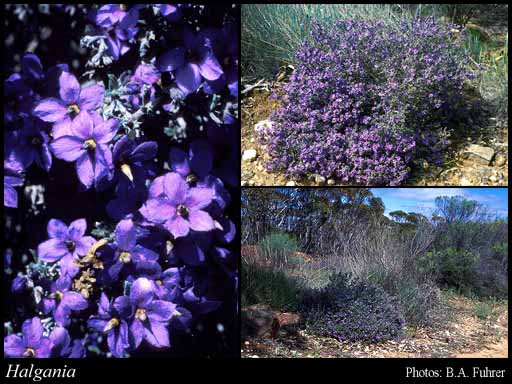- Reference
- Voy.Uranie [Freycinet] pt. 59 (1828)
- Name Status
- Current

Scientific Description
Common name. Halganias. Family Boraginaceae (sometimes separated in Ehretiaceae).
Habit and leaf form. Shrubs, or herbs. To 1.3 m high. Mesophytic. Leaves small to medium-sized; alternate; spiral; ‘herbaceous’, or leathery; petiolate, or subsessile, or sessile; non-sheathing; simple. Leaf blades entire; ovate, or obovate, or oblong; pinnately veined; cross-venulate. Leaves without stipules. Leaf blade margins entire, or crenate, or dentate. Leaves without a persistent basal meristem. Leaf anatomy. Hairs present (hairs without a broad base), or absent; glandular hairs often present, or absent. Unicellular hairs present, or absent. Branched hairs present, or absent. Stem anatomy. Secondary thickening developing from a conventional cambial ring.
Reproductive type, pollination. Fertile flowers hermaphrodite. Unisexual flowers absent. Plants hermaphrodite.
Inflorescence and flower features. Flowers solitary, or aggregated in ‘inflorescences’; in cymes, or in spikes, or in panicles. Inflorescences simple, or compound. The terminal inflorescence unit cymose. Inflorescences terminal; a terminal cyme or panicle of cymes, or sometimes reduced to a short, simple spike. Flowers pedicellate; bracteate, or ebracteate; small; regular; 5 merous; tetracyclic. Free hypanthium absent. Hypogynous disk present. Perianth with distinct calyx and corolla; 10; 2 -whorled; isomerous. Calyx present; 5; 1 -whorled; gamosepalous; lobed; lobulate, or blunt-lobed, or toothed; campanulate, or tubular; regular, or unequal but not bilabiate; persistent; accrescent (sometimes only scarcely). Calyx lobes ovate, or triangular, or linear. Corolla present; 5; 1 -whorled; polypetalous, or gamopetalous; lobed; imbricate, or valvate; regular; hairy abaxially, or glabrous abaxially; blue to purple, or white. Petals ovate. Corolla lobes ovate. Androecial members definite in number. Androecium 5. Androecial sequence not determinable. Androecial members adnate (epipetalous); all equal; coherent (by the anthers, filaments free); 1 -whorled. Androecium exclusively of fertile stamens. Stamens 5. Staminal insertion in the throat of the corolla tube. Stamens becoming exserted; isomerous with the perianth; oppositisepalous; all alternating with the corolla members. Filaments short, flat. Anthers cohering (in a long tube enclosing the style); straight; dehiscing via longitudinal slits; introrse; tetrasporangiate; appendaged. The anther appendages apical (straight or recurved, not twisted). Gynoecium 2 carpelled. The pistil 2 celled, or 4 celled. Carpels reduced in number relative to the perianth. Gynoecium syncarpous; eu-syncarpous; superior. Ovary plurilocular (entire (= not lobed)); 2 locular, or 4 locular (the ‘true’ locules sometimes with incomplete false septa). Locules partially secondarily divided by ‘false septa’, or without ‘false septa’. Gynoecium median; stylate. Styles 1; simple; apical; becoming exserted. Stigmas 2–4 - lobed; minute. Placentation axile to basal. Ovules 1 per locule; pendulous (rarely), or ascending; non-arillate; hemianatropous.
Fruit and seed features. Fruit fleshy, or non-fleshy; indehiscent; a drupe. The drupes with separable pyrenes (1 or 2 pyrenes). Fruit 2 celled, or 4 celled (when 2 2-celled pyrenes present); 2 locular, or 4 locular; 2 seeded, or 4 seeded. Seeds endospermic, or non-endospermic.
Etymology. After Emmanuel Halgan (1771–1852), vice-admiral in the French navy; the plant was collected on Freycinet's expedition 1817–20, a French naval expedition.